
 |
| Every culture has its important annual events. Of the numerous festivals and ceremonial events that punctuate Japan's calendar, perhaps the one to which people are most deeply attached is Shoogatsu, celebrating the beginning of the New Year. School and most workplaces have a holiday that lasts for as much as a week between year-end and the first few days of the New Year, and people spend these days each in their own preferred and accustomed way. Each part of the country has local traditions and customs for celebrating Shoogatsu, but the one custom that people, young and old, man or woman, in every part of the country feel is indispensable is the sending of New Year's cards called nengajoo. In this issue we introduce this greeting-card custom that is so widely and deeply established as part of Japanese life. Unlike greeting cards sent in Western countries, these cards are customarily delivered on the morning of January 1, and the post office mobilizes thousands of extra personnel to accomplish this task. |
| Greeting Card Messages |
As the year-end approaches, everyone from primary school children to their grandparents busy themselves with the task of writing their nengajoo early enough to make sure they will be posted on time. And they look forward to seeing the cards that arrive from friends and relatives. Nengajoo are also exchanged among business associates. Nengajoo bring formal greetings for New Year's and messages wishing the receiver happiness and health. They are intended to express a sense of sharing in bringing in the new year and of hope and celebration, turning over a new leaf as they look forward to the months ahead. In addition, they carry expressions of gratitude for favors received in the preceding year and of hopes for continued close relations in the year ahead. Exchange of nengajoo is both a way of keeping up with acquaintances one is normally out of touch with and of cementing ties with friends, colleagues, and others who have helped one another in various ways. Thus, even the modest postcard plays a big role in lubricating human relations in Japanese society. While most nengajoo today are either printed or produced on word processors, if they include messages written by hand with pen or brush, they can more effectively communicate genuine feeling and warmth. Exchange of nengajoo is both a way of keeping up with acquaintances one is normally out of touch with and of cementing ties with friends, colleagues, and others who have helped one another in various ways. Thus, even the modest postcard plays a big role in lubricating human relations in Japanese society. While most nengajoo today are either printed or produced on word processors, if they include messages written by hand with pen or brush, they can more effectively communicate genuine feeling and warmth.
|
| How Nengajoo Began |
The custom of writing nengajoo goes back to the Heian period (794-1185), and when the modern postal service set up by the Meiji government began to print postcards in 1873 (Meiji 6), postcards began to be sent as New Year's greetings. Sending nengajoo became even more widespread in 1906 (Meiji 39) when the post office started to print specially designated nengajoo. In 1949 (Shoowa 24) the Ministry of Posts
and Telecommunications started its o-toshidama-tsuki nenga hagaki, a nengajo postcard imprinted with numbers in a national lottery,the stakes named after the gifts of money often given to children at New Year's (see The Japan Forum
Newsletter 10, p.11), and the sending of nengajoo became a nationwide practice. Today, national-lottery numbered postcards including a 3-yen donation to various public benefits have been added, and 4.325 billion o-toshidama-tsuki
nenga postcards were printed in 1998 for delivery at New Year's 1999. Statistics show that each household sends an average of 100 nengajoo to relatives and friends. People also send nengajoo at their workplaces as greetings to clients, regular customers, and business associates. It was once the custom for people to pay formal visits directly at the homes of relatives, friends, and neighbors to present their greetings and wishes for the New Year. From the end of World War II, however, this practice rapidly went out of fashion, and the sending of nengajoo came along as a widely favored substitute. People still make a point of visiting their parents and grandparents. Sometimes company employees go to the homes of their superiors and students present themselves at their professor's homes even today. It was once the custom for people to pay formal visits directly at the homes of relatives, friends, and neighbors to present their greetings and wishes for the New Year. From the end of World War II, however, this practice rapidly went out of fashion, and the sending of nengajoo came along as a widely favored substitute. People still make a point of visiting their parents and grandparents. Sometimes company employees go to the homes of their superiors and students present themselves at their professor's homes even today.
|
| Nengajoo Miscellany | ||
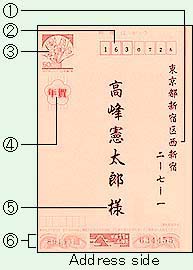  Address: prefecture, county / city / ward, township / town / district / village name, house number ( in this order ) Address: prefecture, county / city / ward, township / town / district / village name, house number ( in this order ) Postal code Postal code Prepaid postcards are ordinarily \50. Prepaid lottery postcards with a printed picture are 5 yen extra, 2 yen to cover design and production costs and 3 yen as a donation to various public benefits. Prepaid postcards are ordinarily \50. Prepaid lottery postcards with a printed picture are 5 yen extra, 2 yen to cover design and production costs and 3 yen as a donation to various public benefits.  ( nenga ) mark ( nenga ) markPostcards with this mark are delivered on or after January 1.   ( sama ) is added to names ( title corresponding to Mr., Mrs., Miss, or Ms. ) ( sama ) is added to names ( title corresponding to Mr., Mrs., Miss, or Ms. )This  must be added to the name of the addressee of any postal item. Address and name of sender should be written in smaller letters than that of addressee. If the address and name of sender appear on the other side of the card, it may be omitted on the front. must be added to the name of the addressee of any postal item. Address and name of sender should be written in smaller letters than that of addressee. If the address and name of sender appear on the other side of the card, it may be omitted on the front. New Year's gift lottery number New Year's gift lottery number | ||
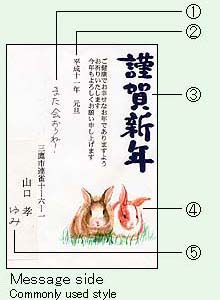  Handwritten Handwritten  ( Heisei 11 ) : In addition to the Gregorean calender, Japanese people use the gengoo system of dates, numbering the years from the beginning of the reign of the current emperor. The present emperor came to the throne in 1989 and the reign name is Heisei, so year 1999 is the
11th year of Heisei. ( Heisei 11 ) : In addition to the Gregorean calender, Japanese people use the gengoo system of dates, numbering the years from the beginning of the reign of the current emperor. The present emperor came to the throne in 1989 and the reign name is Heisei, so year 1999 is the
11th year of Heisei.  ( gantan ) means the morning of January 1. ( gantan ) means the morning of January 1.  . This kanji, written with the character for "sun" above a straight line, expresses the image of the sun rising over the horizon. Instead of using the date the card is written, the cards are dated Heisei 11, gantan ( January 1, 1999. ) . This kanji, written with the character for "sun" above a straight line, expresses the image of the sun rising over the horizon. Instead of using the date the card is written, the cards are dated Heisei 11, gantan ( January 1, 1999. )  Kinga shinnen ( Happy New Year ) Kinga shinnen ( Happy New Year )See nengajoo expressions  Eto ( jikkan juunishi ) : 1999 is the Year of the Rabbit. The ancient Chinese system of the calendar, based on cycles of sixty years, was introduced to Japan in the sixth century. The calendar was created by combining ordered sets of symbols called jikkan ( "10 stems" ) and junishi ( "12 branches" ) The junishi set consists of animals ( Rat, Ox, Tiger, Rabbit, Dragon, Snake, Horse, Sheep, Monkey, Rooster, Dog, Boar, in that order ). This system continues to be used in Japan today to express the year. Eto ( jikkan juunishi ) : 1999 is the Year of the Rabbit. The ancient Chinese system of the calendar, based on cycles of sixty years, was introduced to Japan in the sixth century. The calendar was created by combining ordered sets of symbols called jikkan ( "10 stems" ) and junishi ( "12 branches" ) The junishi set consists of animals ( Rat, Ox, Tiger, Rabbit, Dragon, Snake, Horse, Sheep, Monkey, Rooster, Dog, Boar, in that order ). This system continues to be used in Japan today to express the year. Daily conversation often includes comments about the animal of the year in which one was born. Daily conversation often includes comments about the animal of the year in which one was born. When children use their parent's nengajoo, as in this example, they write their name next to their parent's name. When children use their parent's nengajoo, as in this example, they write their name next to their parent's name. |
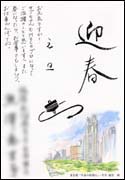 Card with calligraphy |
Card with calligraphy This is an old-style greeting, written with a brush in sumi ink. The nengajoo with public-benefits contribution have pictures or drawings printed on them. This one shows the skyline of Tokyo's Shinjuku area where TJF is located. |
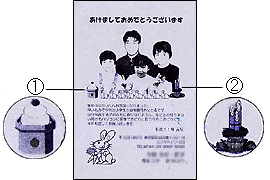 Card with photos |
Card with photos Many families send New Year 's cards printed with a family picture, as in this example. Local photography shops make these cards to order. Here the names of all the family members printed below.  Kagamimochi KagamimochiProsperous-looking large rice cakes (as big as a kagami or circular mirror of the ancient type)are stacked as an offering to the gods at New Year's.  Kadomatsu KadomatsuPine is the symbol of longevity and bamboo a symbol of prosperity because pine is evergreen and bamboo grows quickly. Decorations made of pine and bamboo are placed inside and outside houses and businesses at New Year's. |
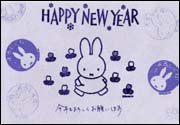 Original-design nengajoo |
Original-design nengajoo Many people enjoy designing their own nengajoo with original drawings, stamps, or block-printed decorations. Recently more people are printing their own nengajo using computers or word processors. Happy New Year : Greetings in English are used quite commonly. |
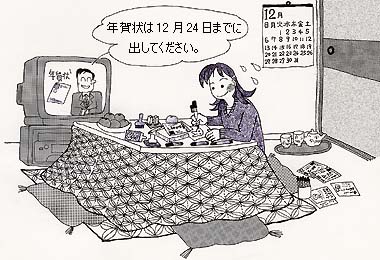 Illustration : Asayama Yuki |
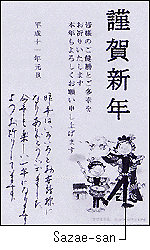 |
|
1998 Nov. 2 (Mon.) Lottery-numbered nenga postcards put on sale ( 3,633,400,000 printed ). Nov. 13 (Fri.) Public-benefit and lottery-numbered nenga postcards put on sale ( 5,816,000,000 printed ). Nov.16 (Mon.) Additional printing of 10 million donation and lottery-numbered nenga postcard featuring Sazae-san, the cartoon character popular among Japanese of all ages. Nov.27 (Fri.) Additional printing for the Tokyo area of 1 million more Sazae-san postcards, which had proved very popular. | |

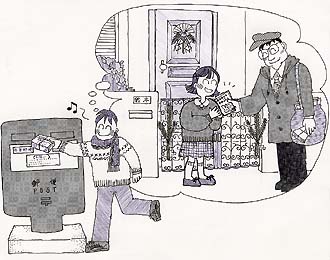 Illustration : Asayama Yuki | 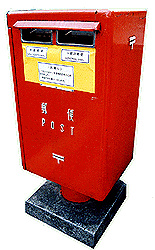 |
|
Dec.15 (Mon.) First day for posting nengajoo. A ceremony was held of the "first postcard sent" and special nengajoo receptacles were set up in post offices to facilitate the sorting process. Senders separate their nengajoo into local city, local prefecture or metropolis, and other prefectures, and bundle them with rubber bands before posting. Handled separately from ordinary mail, nengajoo are sorted and then kept at the local post office until Jan. 1. The post office encourages every one to post their nengajoo by December 24 so that they can be delivered time to any part of the country. | |

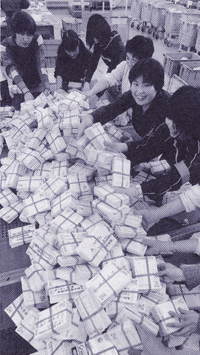 Photo : Asahi Shimbun |
1999 Jan.1 (Fri.) at 8:00 A ceremony was held at the Shinjuku main post office, in the presence of the Minister of Posts and Telecommunications, launching the delivery of New Year's mail. At a signal, postmen across the country leave their local post offices to begin delivery of nengajoo. Every year, the post office hires numerous student part-timers to help sort and deliver New Year's mail in the attempt to meet the Jan. 1 morning deadline. ( Nengajoo are delivered as priority mail until Jan. 8. ) |
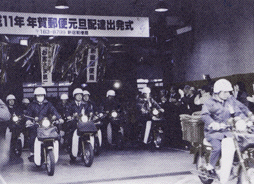 Photo : Ministry of Posts and Telecommunications |
|
| When you receive a nengajoo from someone who you did not mail one to, you can send a return nengajoo until Jan.7. Postcards sent after that date fall into a different category known as " kanchuu mimai, " or winter greetings. | |

Jan.15 (Fri.) Announcement of lottery prize-winning numbers Winners may claim their prizes between January 18 (Mon.) and July 19 (Tues.). Every year, the prize-winning numbers in the national nengajoo lottery are published in the evening news and announced on television on the evening of January 15th. This year, the top prizes include digital video cameras, televisions, and washing machines; second prizes include health meters and pedometers, six small packets from a choice of one hundred types of local products including apples from Aomori, green tea from Shizuoka, etc., digital cameras, electronic system date books, mini-disc players, sets of futon, and other items; third prize includes one small packet from a choice of the local products mentioned above, and fourth prize consists of commemorative postage stamps printed with the eto animal of the year. |
| Original text : The Japan Forum Newsletter no12 " A day in The Life " February 1999. |
Send feedback to forum@tjf.or.jp
 ( Akemashite omedetoo gozaimasu )
( Akemashite omedetoo gozaimasu ) ( Akemashite ) derives from
( Akemashite ) derives from  ( akeru ); to dawn, open, begin, as in "one year ends and the new year begins"
( akeru ); to dawn, open, begin, as in "one year ends and the new year begins" ( Omedetoo ); expresses congratulations, used when people celebrate something
( Omedetoo ); expresses congratulations, used when people celebrate something Adding gozaimasu makes the expression of congratulations more polite.
Adding gozaimasu makes the expression of congratulations more polite. meaning reverence, respectfulness
meaning reverence, respectfulness meaning celebration, joy
meaning celebration, joy New Year
New Year ( Geishun )
( Geishun ) for greeting or welcoming
for greeting or welcoming for spring
for spring



 ( often used by children )
( often used by children )
